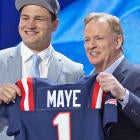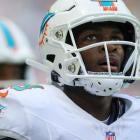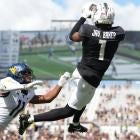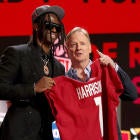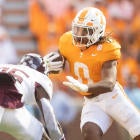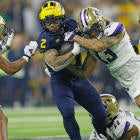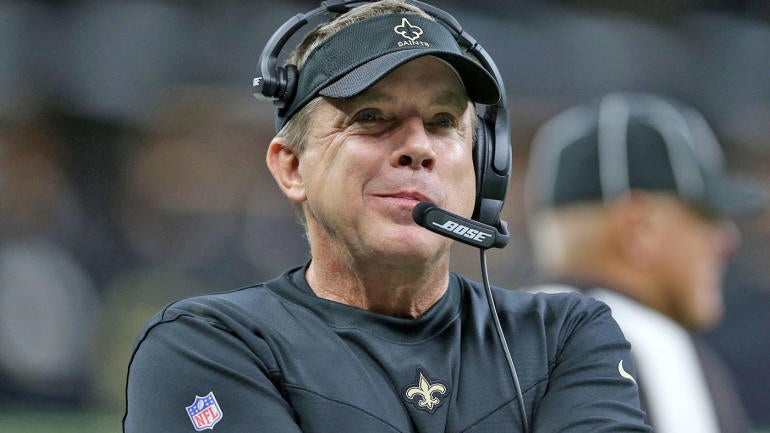
Sean Payton was easily the most qualified head coach available this winter. Not only was he the best offensive playcaller and game planner on the market, but he's widely considered one of the best playcallers ever.
In 15 seasons with the Saints, Payton's offense ranked first in total yards six times and top-10 a staggering 12 times. His run game never ranked higher than fifth-best (2017) and was top-10 only five times. But his passing game, led by legendary passer Drew Brees, topped the league in yards gained five times and was a top-10 unit on 11 occasions.
That would suggest that Brees was the biggest reason for Payton's success, a theory that makes all the sense in the world since Payton's two worst seasons in passing offense were either when Brees' production collapsed as Father Time caught up with him or when Brees retired.
But Payton also made magic in some different ways with the Giants from 2000 to 2002, overcoming some passing inefficiencies with Kerry Collins and leaning heavily on the thunder & lightning combo of Ron Dayne and Tiki Barber. They were top-13 in total yards and top-15 in rushing yards each season, and they made the Super Bowl in 2000. Payton wasn't quite as successful in terms of rankings while with the Cowboys from 2003 to 2005, but he wasn't calling plays. He did, however, have a hand in cultivating Tony Romo from a total unknown into the eventual Cowboys starter.
(In fact, Payton tried to trade for Romo when he landed with the Saints in 2006, but the Cowboys asked for too much in return. Payton and the Saints signed Brees instead.)
And think back to how Payton has unearthed some pretty special skill-position players and turned them into major contributors. Jimmy Graham, Marques Colston, Lance Moore and Pierre Thomas all qualify, as do Alvin Kamara, Michael Thomas and even Taysom Hill.
Furthermore, there's a lot of consistency in Payton's numbers from his 15 seasons in New Orleans. We should feel good about certain positions and directions this offense will go with Payton calling the shots moving forward.
Pass-run ratio
Over his time with the Saints, Payton called pass plays 59% of the time. That shouldn't surprise anyone considering who the quarterback was for 14 of those years. But it is worth pointing out the pass-run ratios late in his tenure when Brees' arm was in decline, and then in 2021 when Jameis Winston, Trevor Siemian and Taysom Hill were his quarterbacks.
- 2017: 56% pass
- 2018: 53% pass
- 2019: 60% pass
- 2020: 53% pass
- 2021: 51% pass
What does this mean for 2023? Will Payton be as fired up to call a lot of pass plays if Russell Wilson's accuracy and overall playmaking skills never return to the level they were at when he was in Seattle? Denver threw the ball at a 59.6% rate last season with Nathaniel Hackett calling plays, then cooled off to 53.1% in their final two once Hackett was fired. Wilson was a much more efficient passer in those last two, completing 62.9% of his throws with a higher average target depth (7.98) and a better quarterback rating (96.5). A three-score game against an uninterested Chargers defense certainly helped.
It remains to be seen if Payton will scheme up Wilson to do the things he loved doing with the Seahawks: fire downfield and make improvisational plays. The coach could lean on that if he believes those are still Wilson's strengths. But what if Payton thinks the Broncos are better off keeping things run-centric and not unloading a ton of deep balls? For context, Brees' attempts per game went from as high as 42.1 in 2016 to 32.6 in 2018 to 32.5 in 2020, and his ADOT went from as high as 8.3 in 2009 to 7.16 in 2018 to 6.43 in 2019 to 6.03 in 2020. People get old and there is a drop-off, and Payton knows it.
This will come down to how well Wilson throws with the Broncos moving forward. If he looks like his old self in camp, Wilson will have 3,700-yard, 30-touchdown potential. If he doesn't, he'll be a bust in Fantasy much like he was in 2022.
RB outlook
In Payton's 15 years with the Saints, running backs averaged 23.3 attempts per game. That was a pretty steady average too -- Payton's backs always averaged around 21 to 23 carries per game save for these outlier years:
- 2006: 26.7 (Deuce McAllister's age-28 year, Reggie Bush's rookie year)
- 2011: 26.9 (Mark Ingram's rookie year with help from others)
- 2017: 24.6 (Alvin Kamara's rookie year)
- 2018: 24.2 (Kamara's second year)
It's enough to suggest that running backs won't be ignored too often, if at all. But don't count on one running back taking a massive majority of the carries. Payton had a Saints RB get at least 200 rush attempts just five times in 15 seasons, three by Ingram (2014, 2016, 2017). And at no time in 15 seasons did a Saints running back have 250-plus carries.
What about total touches? Better news there -- there were eight occasions when a running back had at least 250 touches for Payton, half of them by Kamara (2018, 2019, 2020, 2021).
Considering this information, you're probably assuming RB receiving numbers for the Saints were pretty good. You'd be correct.
Running backs have been incredibly productive with Payton, perhaps more so than with any playcaller in the league. It's good when a team has 20% of its receptions go to the running back position. Payton's backs in New Orleans averaged an incredible 31.1% of receptions per year including three seasons where that topped 35%:
- 2006: 42.5% (Bush's rookie year)
- 2013: 38.3% (Pierre Thomas and Darren Sproles each caught 70-plus balls)
- 2017: 37.0% (Kamara's rookie year)
The lowest reception rate for running backs under Payton? 24.7%, when Bush played just eight games in 2010. Even when he was with the Giants his running backs (mainly Tiki Barber) caught anywhere from 29% to 37% of all receptions.
Additionally, Payton's offensive lines have typically been very strong. Pro Football Focus rated them as a top-10 run-blocking unit in 7 of his 15 seasons and a top-10 pass-blocking squad in 6 of his 15 seasons. Expect the O-line to be a major priority for Payton.
What does this mean for 2023? Payton's trend could get tested by Russell Wilson's tendency to NOT throw to running backs. In his 11 seasons, Wilson has thrown 20% or more of his receptions to running backs just twice. That includes six seasons below 18%.
There's still hope for a change from Wilson. For one thing, Wilson set a career-high in targets to running backs this past season with 23.6%, exceeding his previous high of 21.3% in 2018. He even targeted running backs 22.7% of the time inside the 10-yard line.
Wilson and Payton might already have the perfect running back in Javonte Williams. He had the highest target per route run rate of all qualifying Broncos RBs last year (target on 31.9% of his routes) and also led Denver with six red-zone targets from Wilson (half came in Week 1); no other Broncos back had more than two.
When we start getting reports of Williams' knee not being an issue, then we'll see his Fantasy stock erupt. There's unreal potential, but it'll take his health, his coach, his O-line, the depth chart (he won't be alone) and his quarterback all being aligned for it to happen. That's a lot. I'll probably let someone else grab Williams in Fantasy drafts next August but if he's somehow on the board at 50th overall I'd snag him.
TE outlook
Whereas Payton has seemingly made it a point to involve running backs in the passing game, he's really only utilized tight ends when he's had one worth leaning on.
- 2006-07: 14.7% of receptions went to TE (best one: Eric Johnson)
- 2008-2010: 24.3% of receptions went to TE (best one: Jeremy Shockey)
- 2011, 2013-2014: 24.6% of receptions went to TE (best one: Jimmy Graham)
- 2015: 22% of receptions went to TE (best one: Benjamin Watson)
- 2016-21: 15.8% of receptions went to TE (best one: Jared Cook)
What does this mean for 2023? If the Broncos didn't have a tight end who could separate from coverage or make contested catches, then this would probably end up being a non-issue. But Greg Dulcich flashed a number of times during his rookie year -- he even was 11th among all tight ends in ADOT (11.35) and top-20 in explosive plays (nine). Not bad for a guy who played only 474 snaps and saw only 55 targets.
At 6-foot-4, 245 pounds and with 4.69 speed in the 40, Dulcich could absolutely be the next tight end Payton winds up utilizing. His 17.9% target per route run rate with Wilson isn't a terrible sign either -- they can build on their work from 2022. Dulcich is a breakout candidate who won't quite get drafted like one -- he's seemingly fine in Round 8 or later.
WR outlook
So if Payton has an aggressive tendency with his running backs and leans on his tight ends when he's got a special one, what's left for his receivers?
The reception percentage, which sits at 48.6% over his 15 seasons, suggests there isn't much. But that's not entirely the truth.
- A wideout has had at least 1,000 yards in 10 of 15 seasons
- A wideout has had at least seven touchdowns in 10 of 15 seasons
That's the good news. The bad news:
- There's been one season when two wide receivers each had 1,000-plus yards (2016)
- There's been two other seasons when two wide receivers each had 900-plus yards (2014, 2015)
- There have been only six instances of a wide receiver seeing 120-plus targets (four by Michael Thomas)
What does this mean for 2023? Pretty much all of this makes sense when you consider that Payton's running backs and tight ends, on average, have caught over 50% of his team's receptions. There just isn't enough meat left on the bone for multiple receivers to have big seasons.
But there is enough for one, and the odds-on favorite to be that one is Jerry Jeudy. Though he has yet to land a 1,000-yard season of his own, Jeudy did take a step forward in terms of production and efficiency in 2022. He stopped being allergic to the end zone (six scores) and set a career-high in yards per target (9.7). Jeudy still has work to do in terms of holding on to the football (six drops in 2022) and he's really a liability on contested catches (36.6% career rate per Pro Football Focus), but there's no denying his route-running ability or speed, and that should be enough to make him Denver's best receiver next year.
Jeudy will be worth a Round 4 pick, but expect a bunch of folks to target him and potentially push his ADP well into Round 3. That might be too rich for me. However, he's the only Broncos wideout worth taking until Round 8, when Courtland Sutton stands as a solid bench receiver. Tim Patrick and K.J. Hamler don't quite offer enough to get drafted in a 15-round league at this time.














